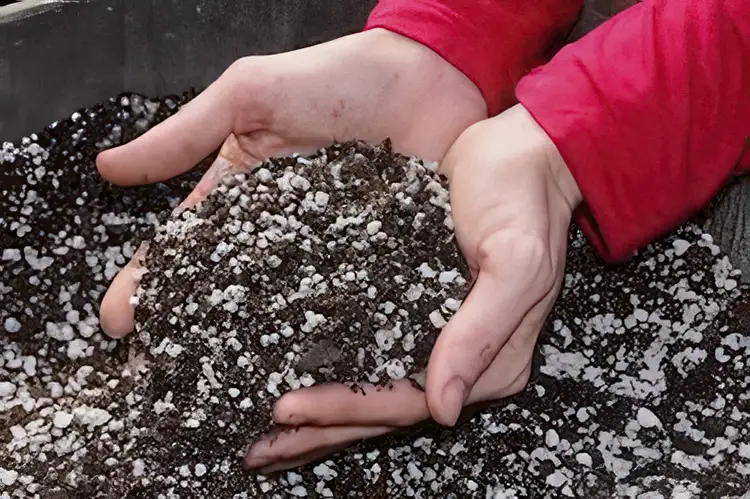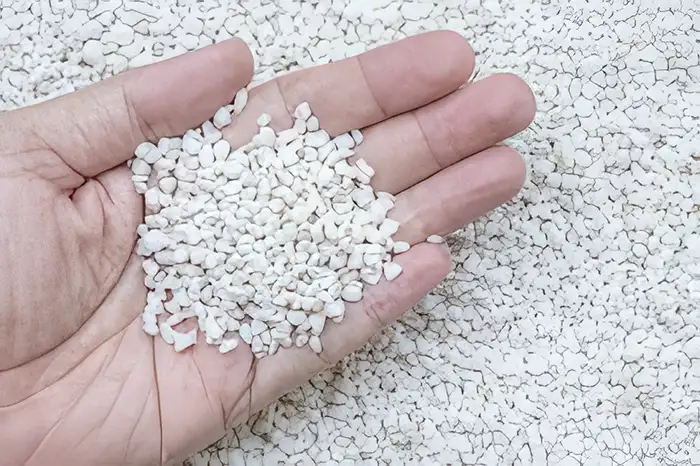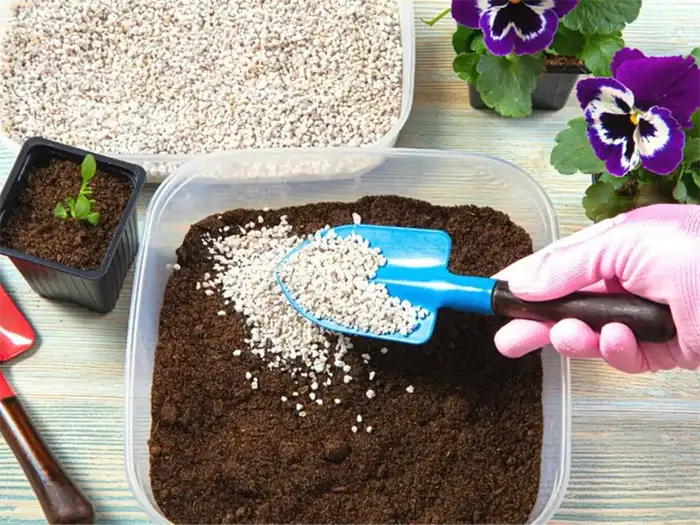Beautiful Plants For Your Interior
Perlite: A Gardener’s Guide to Uses, Benefits, and More

What Exactly is Perlite?
Perlite is a lightweight granular material, that is porous, sterile and white in colour. However, if you are looking to improve the drainage and aeration of the soil in your garden? Then ‘perlite’ is the answer.
I know it might look like little bits of polystyrene, but it’s actually expanded volcanic glass, and it can make a big difference to your plants. It’s great for starting seeds, rooting cuttings and for plants that hate sitting in water, like cacti and succulents.
Above is just a quick look at how ‘perlite’ can help your plants thrive. To really understand how to use it and make the most of its benefits, keep reading for a deep dive into the world of perlite. I’ll cover everything from how it compares to vermiculite, to how to use it in your garden, to what you need to know about handling it safely.

Perlite Can help plants thrive despite being sterile.
Key Uses of Perlite in Gardening
Perlite is primarily used in gardening to improve soil structure, particularly aeration and drainage. While ‘perlite’ can help with water retention, its primary benefit is improving drainage. The porous structure of perlite creates air gaps in the soil, allowing plant roots to access the oxygen they need. Additionally, perlite helps to prevent soil compaction, ensuring the soil remains loose and well-draining.
Perlite is used in a variety of applications
- Potting Mixes: Perlite is a valuable addition to potting mixes, especially for plants that are sensitive to overly moist soil, such as cacti and succulents. It ensures that water drains away from the roots, preventing them from sitting in damp soil. For general use, a 1:4 ratio of perlite to compost is recommended.
- Taking Cuttings: Perlite can aid in water retention within compost, which improves the chances of cuttings taking root. A 50:50 mix of perlite and cutting-specific compost is recommended for this purpose. Cuttings can also be rooted in perlite alone.
- Seed Sowing: Perlite is useful for creating a moist environment ideal for the development of delicate seedling roots. A 50:50 mix of perlite and seed compost is recommended. A fine layer of ‘perlite’ can also be used to cover seeds that need light to germinate, as it keeps them moist while allowing light to reach the seeds.
- Perlite can be used as a replacement for sand or grit in potting composts. It’s ideal for creating a free-draining potting mix.
Perlite vs. Vermiculite
Vermiculite is another commonly used soil additive that shares some similarities with perlite. Both materials are inorganic, lightweight, and sterile, and are created by superheating their base materials. However, they have distinct differences. Perlite is derived from volcanic glass, while vermiculite is made from mica.
Key differences include:
- Perlite: This is a hard, porous material primarily used to improve aeration and drainage. It has a slightly alkaline pH and releases water relatively quickly. Perlite can however retain 3 to 4 times its weight in water.
- Vermiculite: Sold as bags of ‘brown-gold flakes’ in garden centres or online. This soft, spongy material is known for retaining water and nutrients. It has a nearly neutral pH and releases water more slowly. Vermiculite can absorb up to 4-6 times its weight in water.
The specific properties of each material make them suitable for different purposes.
- Use perlite for plants that require good drainage, such as cacti and succulents.
- Use vermiculite for plants that need more moisture, such as when starting seeds.
- It’s possible to use both materials together. Perlite can be mixed into seed-sowing mixes. to ensure the roots receive sufficient oxygen, while a topping of vermiculite can help to lock in moisture.

Mixing perlite with compost and vermiculite is a common garden practice.
Other Benefits of Using Perlite
Perlite helps with both water retention and drainage, preventing waterlogging and encouraging healthy root growth. It is sterile, making it suitable for starting seeds and preventing disease. The lightweight nature of perlite makes it easy to handle. Using perlite can also help prevent root rot.
Potential Drawbacks of Using Perlite
Perlite is dusty, which can irritate the respiratory tract, skin, and eyes. It is recommended to wear gloves and a mask when handling perlite. Dampening the perlite before use will also reduce dust.
Because it is very lightweight, perlite can be washed away, making it unsuitable for flood-and-flush hydroponic systems. As it, maintains moisture, perlite can also encourage algae growth if you are not careful, do not overwater your plants. Perlite does not actively contribute to plant nutrition. Finally, perlite is a non-renewable resource.
Other Uses of Perlite
Perlite has many other applications outside of gardening:
- Construction and manufacturing: Perlite is used in lightweight plasters, concrete, mortar, insulation, and ceiling tiles.
- Aquatic filtration: Perlite is used in commercial pool filtration and sewage systems.
- Biotechnology: Perlite is used to support the immobilization of biocatalysts, such as enzymes.
- Cosmetics: Perlite is used as an absorbent and mechanical exfoliant in cosmetics.
- Other uses include cat litter, foundries, beer manufacturing, ceramics, and in the explosives industry.
Perlite What is it? How to use it?
Perlite Composition, Sourcing, and Safety
How to Buy and Use Perlite
Perlite is widely available in nurseries, garden centres, and DIY stores. Due to its lightweight nature, it is also easily ordered online.
Standard particle size is between 2.0 and 5.0mm, however, a finer grade of perlite is recommended for use as a propagation medium.
Before using perlite, it should be dampened to reduce dust. When handling large quantities of perlite, it’s recommended to wear goggles and a silica-filtering mask to prevent irritation from the dust.
To mix perlite with compost, use the ratios described earlier in the post, depending on the application. Perlite can also be used in hydroponic systems, where roots grow directly in the perlite with a nutrient solution.
Perlite is considered to be a non-renewable resource. The world reserves are estimated at 700 million tonnes. China, Turkey, Greece, the USA, Armenia, and Hungary are the leading producers of perlite, with a combined production of 4.6 million tonnes in 2018.
Substitutes for Perlite
There are substitutes for perlite in all of its various applications. These include:
- Diatomite (used for filter aids)
- Expanded clay (a lightweight filler for building materials)
- Shale
- Pumice
- Slag
- Vermiculite
Conclusion
Perlite is a valuable tool for gardeners thanks to its unique properties that improve aeration and drainage in the soil. It is particularly useful for growing succulents, starting seeds, and taking cuttings.
Despite its drawbacks, such as being a non-renewable resource and its potential to irritate, perlite is a versatile and effective material for improving plant health and growth. By understanding its uses and how to handle it properly, you can make use of perlite to improve your plant growth.
FAQ’s
What are the main benefits of using perlite in gardening?
Perlite primarily improves soil structure by enhancing aeration and drainage. Its porous nature creates air pockets, allowing plant roots to access the oxygen they need. It also helps to prevent soil compaction, ensuring water drains freely.
How does perlite help with drainage?
The porous structure of perlite allows water to drain through the soil rather than accumulating around plant roots. This is especially beneficial for plants that are sensitive to wet conditions. It helps maintain an ideal balance of air and moisture around the roots.
Is perlite the same as vermiculite?
No, while both are soil additives, they have different properties. Perlite is primarily for aeration and drainage, while vermiculite is better for water retention. Perlite is hard and slightly alkaline, while vermiculite is soft and more neutral.
When should I use perlite instead of vermiculite?
Use perlite for plants that need good drainage, such as cacti and succulents. Use vermiculite for plants that require more moisture, such as when starting seeds.
Can I use perlite and vermiculite together?
Yes, combining them can be beneficial. For instance, using perlite in a seed mix will ensure aeration, while topping with vermiculite can lock in moisture.
What are some common uses for perlite in gardening?
Perlite is commonly used in:
Potting Mixes
Taking Cuttings
Seed Sowing
Hydro Ponics
As a replacement for sand or grit in potting composts
What ratio of perlite to compost should I use?
For general use to improve drainage, mix at a ratio of around 1:4 (perlite to compost).
When taking cuttings or sowing seeds, use a 50:50 mix of perlite and cutting compost.
For succulents and cacti, you can use higher ratios of perlite.
For larger containers with larger plants, add 25% perlite to all-purpose compost.
Does perlite provide any nutrients to plants?
No, perlite itself does not add any nutritional value to the soil. Its primary function is to improve drainage and aeration. You should use compost or fertiliser for better growth.
Can perlite be used in hydroponics?
Yes, perlite is an effective medium for hydroponics. It allows the correct amount of water and oxygen to reach the root systems of plants.
Can I reuse perlite?
Yes, perlite can be reused provided it is steam pasteurised.
Where can I buy perlite?
Perlite is widely available in nurseries, garden centres, and large DIY stores. It can also be easily ordered online.
How does perlite help with seed germination?
Perlite creates a moist yet well-drained environment for root development in seedlings. A fine layer of perlite can cover seeds that need light to germinate, as it lets light through while keeping the seed moist.
Can perlite be used in large containers?
Yes, perlite can create a well-drained environment in large containers, promoting healthy root growth.
How does perlite help in preventing soil compaction?
Perlite’s structure provides air gaps, preventing the soil from becoming too dense. This is beneficial for root health and drainage.
